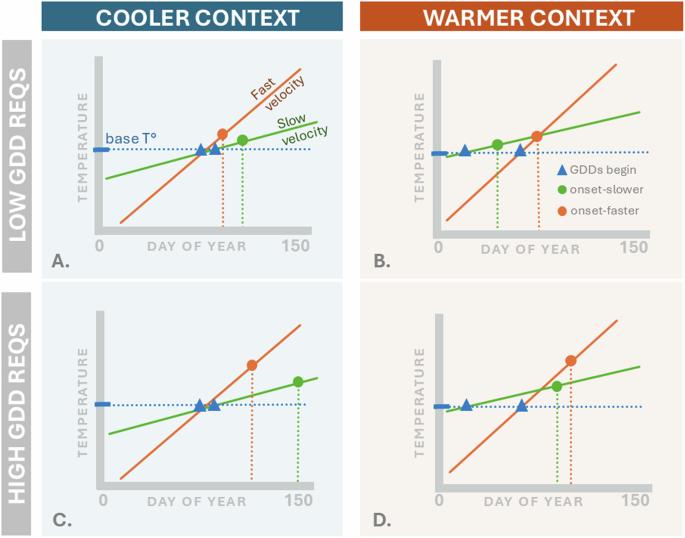对气候变化的物候反应取决于春季变暖速度
IF 8.1
1区 地球科学
Q1 ENVIRONMENTAL SCIENCES
引用次数: 0
摘要
气候变迁正在极大地改变物候,但有关反应速度和模式的一般性结论仍然有限。在此,我们提出了一个包含春季温度、春季升温速度和物种热需求的一般模型框架,用于预测物种对气候变暖的物候反应。该框架的一个关键预测是,在春季气温升高速度最低的温暖地区,在季节早期活跃的物种对气候变化的敏感性最强,对气候变暖的反应速度也最快。我们利用 19 世纪 50 年代和 2010 年代收集的植物物候数据集检验了这一预测。我们的结果惊人地证实了模型的预测,表明虽然低温速度地区对温度的敏感性更高,但气候变暖速度最快的北部地区物候期开始时的变化最大。我们的框架为预测温带地区、多种植物物种以及潜在的其他物种群的物候敏感性和响应性提供了更强的实用性。根据美国东部植物物候数据测试的模型框架,春季气温速度会影响植物开花和落叶的周期,在气候变暖速度最快的地区,物候变化最大。本文章由计算机程序翻译,如有差异,请以英文原文为准。

Phenological response to climatic change depends on spring warming velocity
Climatic change is dramatically altering phenology but generalities regarding tempo and mode of response remain limited. Here we present a general model framework incorporating spring temperature, velocity of spring warming, and species’ thermal requirements for predicting phenological response to warming. A key prediction of this framework is that species active earlier in the season and located in warmer regions where spring temperature velocity is lowest show strongest sensitivity to climatic change and greatest advancement in response to warming. We test this prediction using plant phenology datasets collected in the 1850s and 2010s. Our results strikingly confirm model predictions, showing that while temperature sensitivity is higher in regions with low temperature velocity, the greatest realized change in phenological onset is northern areas where warming rates have been fastest. Our framework offers enhanced utility for predicting phenological sensitivity and responsiveness in temperate regions and across multiple plant species and potentially other groups. Spring temperature velocity impacts cycles of plant flowering and leaf-out, and realized change is greatest in areas where warming is most rapid, according to a model framework tested against Eastern USA plant phenology data.
求助全文
通过发布文献求助,成功后即可免费获取论文全文。
去求助
来源期刊

Communications Earth & Environment
Earth and Planetary Sciences-General Earth and Planetary Sciences
CiteScore
8.60
自引率
2.50%
发文量
269
审稿时长
26 weeks
期刊介绍:
Communications Earth & Environment is an open access journal from Nature Portfolio publishing high-quality research, reviews and commentary in all areas of the Earth, environmental and planetary sciences. Research papers published by the journal represent significant advances that bring new insight to a specialized area in Earth science, planetary science or environmental science.
Communications Earth & Environment has a 2-year impact factor of 7.9 (2022 Journal Citation Reports®). Articles published in the journal in 2022 were downloaded 1,412,858 times. Median time from submission to the first editorial decision is 8 days.
 求助内容:
求助内容: 应助结果提醒方式:
应助结果提醒方式:


